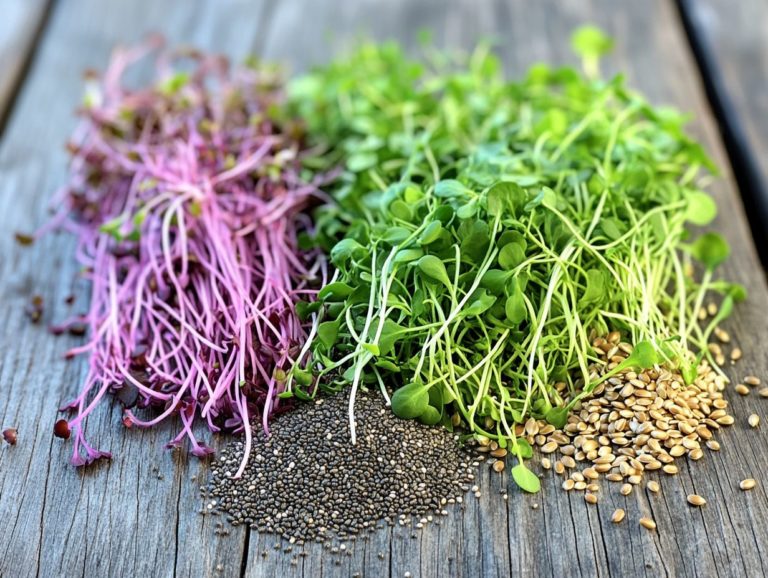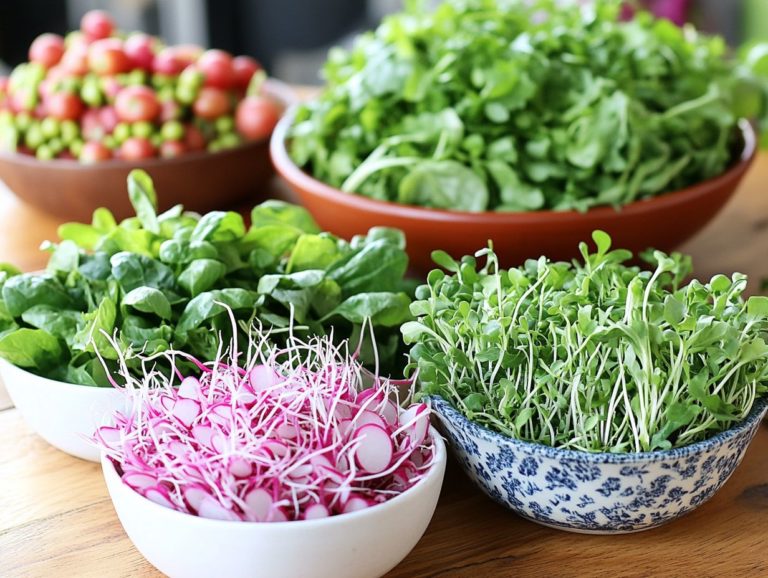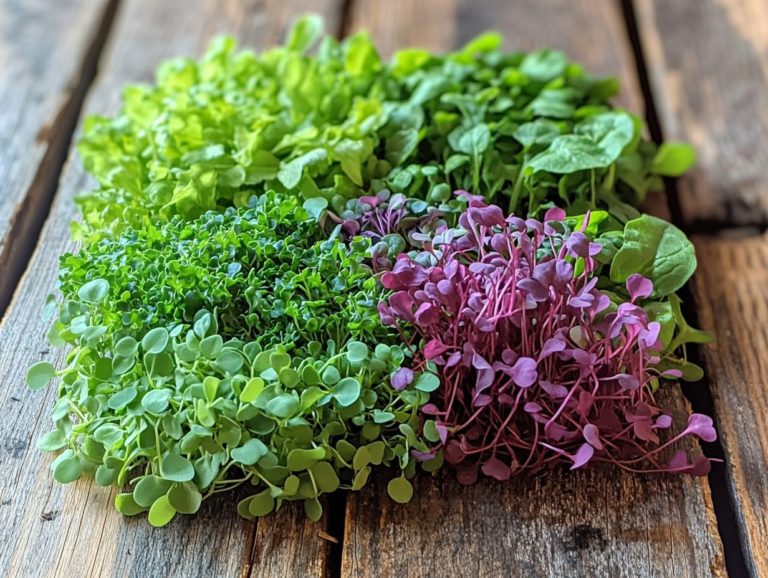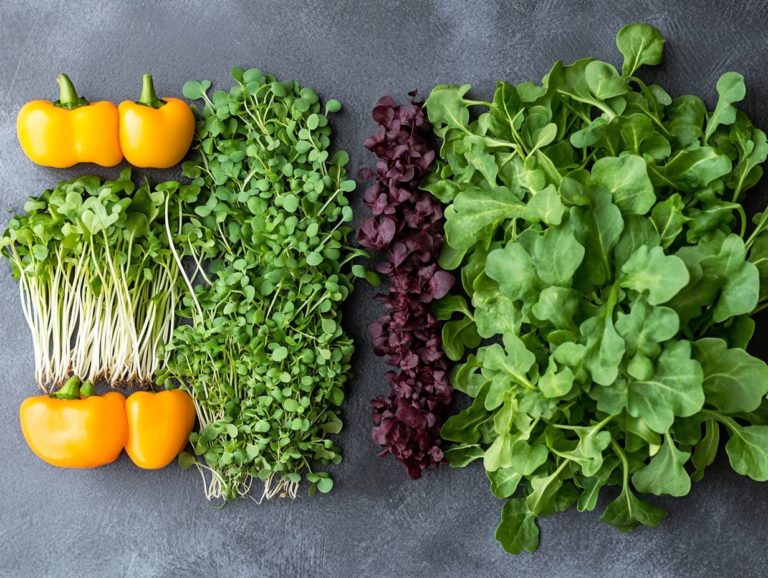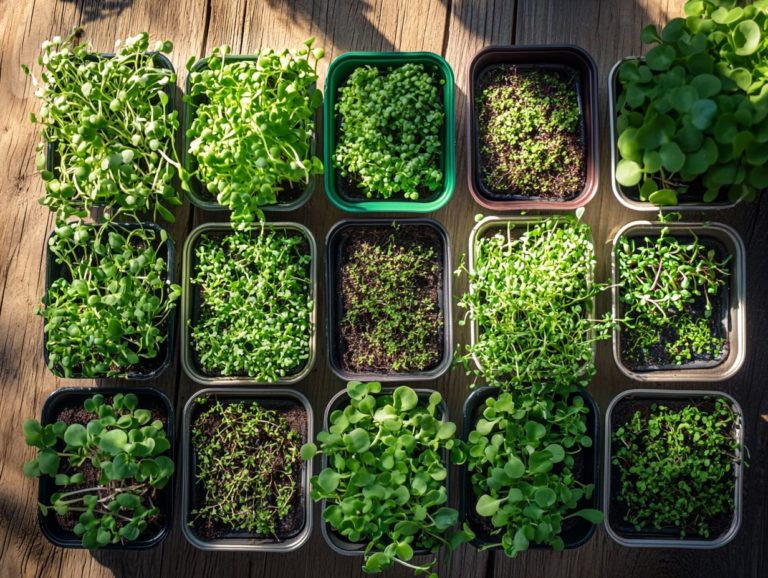Microgreens and Their Superfood Status
Microgreens have truly revolutionized the culinary landscape, celebrated not only for their vibrant hues and exquisite flavors but also for showing how they can be good for your health.
These petite greens deliver an impressive array of antioxidants and essential nutrients, making a significant contribution to your overall health, particularly in the context of weight management and disease prevention. This article delves into the world of microgreens, examining what they are, their health advantages, and how you can grow and incorporate them into your meals, emphasizing their commercial significance in the urban farming sector.
Furthermore, it offers a comparison with other superfoods, showcasing their distinctive benefits, particularly regarding their antioxidant potential and nutritional content. Discover why these small greens deserve a prominent place on your plate!
Contents
- Key Takeaways:
- What are Microgreens?
- Health Benefits of Microgreens
- Growing and Harvesting Microgreens
- Incorporating Microgreens into Your Diet
- Why Microgreens Outshine Other Superfoods
- Frequently Asked Questions about the Culinary World of Microgreens
- What are microgreens and what makes them a superfood?
- What types of microgreens are commonly grown and consumed?
- How do microgreens differ from sprouts?
- What are some benefits of incorporating microgreens into your diet?
- How can microgreens be incorporated into meals?
- Are there any precautions to take when eating microgreens?
Key Takeaways:
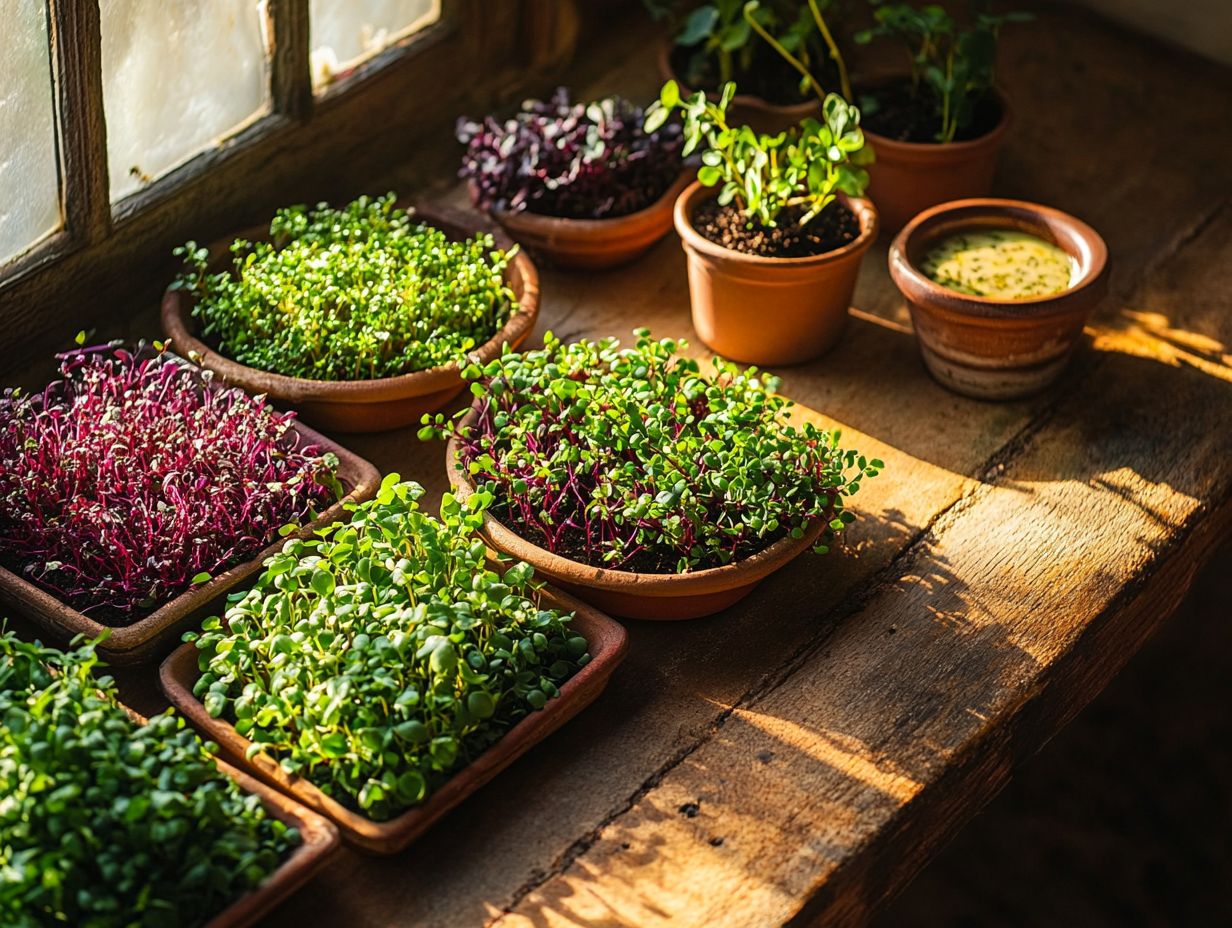
- Microgreens are small, nutrient-packed versions of mature vegetables and herbs, containing high levels of antioxidants and essential vitamins and minerals.
- Adding microgreens to your diet may help prevent diseases and improve overall health due to their potent antioxidant and nutrient content.
- With a simple step-by-step guide, anyone can easily grow and harvest their own microgreens at home, making it a cost-effective and convenient way to incorporate superfoods into your diet.
What are Microgreens?
Microgreens are the young seedlings of edible vegetables and herbs, harvested shortly after the first leaves emerge, usually within a brief window of 7 to 21 days. These nutrient-dense greens grace culinary creations with their vibrant colors and bold flavors, providing not only visual allure but also a robust nutritional profile that can significantly enhance your overall health.
As urban farming gains traction, the importance of microgreens in modern agriculture is becoming increasingly apparent, particularly regarding the best growing methods that help combat climate change.
Definition and Nutritional Profile
Microgreens are young, edible plants that you can harvest shortly after they germinate, and they re full of healthy substances that elevate them to the status of functional foods.
These vibrant little wonders, including varieties like arugula, radish, and basil, offer an impressive range of vitamins, minerals, and antioxidants that often outshine their fully grown counterparts. Research has shown that microgreens can contain up to 40 times more nutrient density than adult plants, making them true powerhouses in the realm of healthy eating. For more information on their benefits, check out why microgreens are superfoods you need. Their rich content of vitamins C, E, and K, along with carotenoids and flavonoids, contributes to their notable anti-inflammatory and antioxidant benefits.
By incorporating microgreens into your daily meals, whether you sprinkle them on salads or blend them into smoothers, you can significantly enhance your nutrient intake and support your overall wellness. This makes them a vital addition to any health-conscious diet, as highlighted in the benefits of eating microgreens daily.
Health Benefits of Microgreens
You ll be amazed by the incredible health benefits of microgreens! They boast impressive antioxidant properties, which can enhance your overall well-being.
These nutrient-dense greens can also help you manage your weight and lower the risk of diseases, including cardiovascular issues and colorectal cancer. Incorporating microgreens into your diet is a smart choice for a healthier lifestyle.
Antioxidant and Nutrient Content
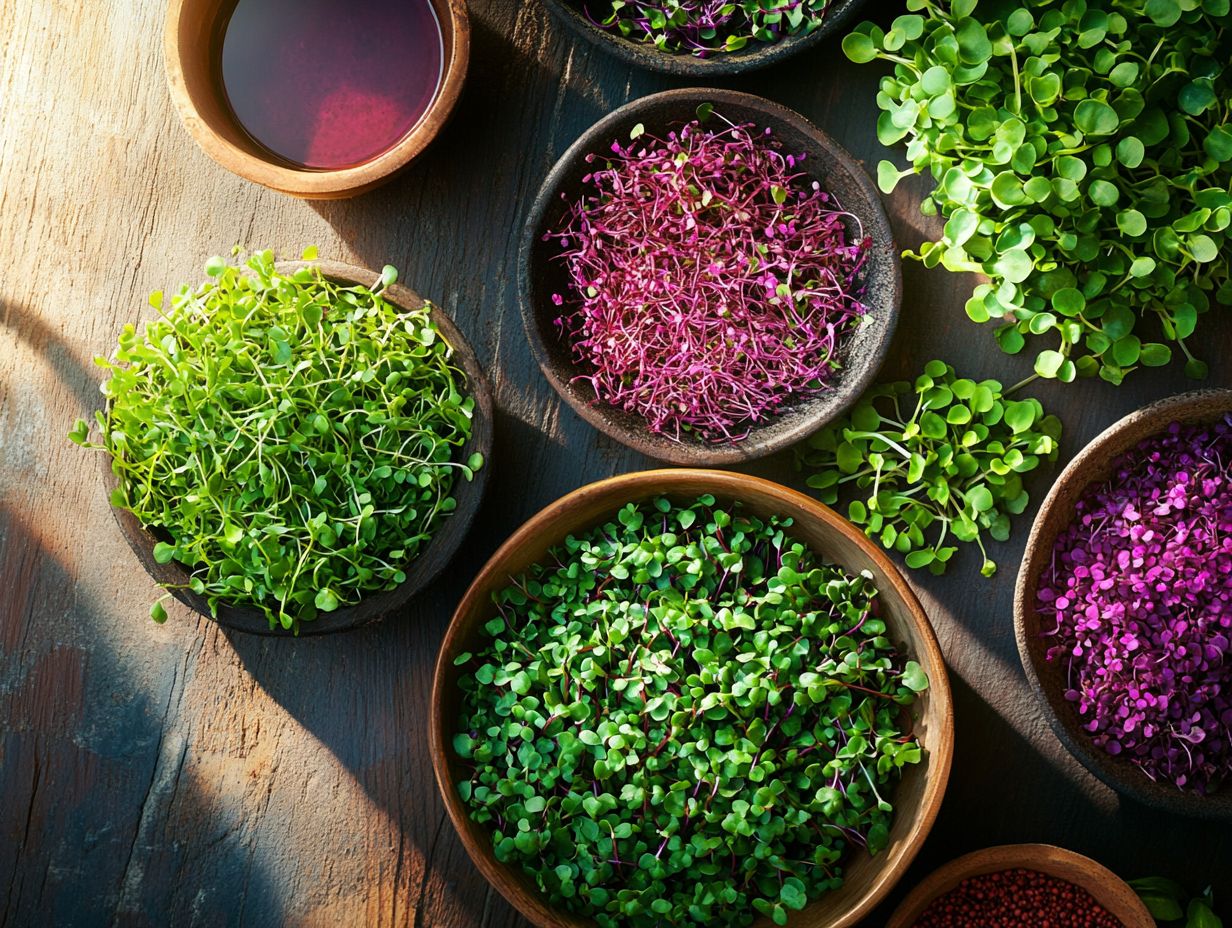
Microgreens are celebrated for their remarkable antioxidant potential, often surpassing that of their fully grown counterparts. They are brimming with essential vitamins and phytochemicals vital for your health.
These tiny powerhouses are a feast for the eyes and a significant nutritional asset. They offer a stunning array of compounds that combat damage from free radicals within your body. Varieties like kale, broccoli, and radish microgreens are packed with substantial levels of vitamins C and E and beneficial antioxidants like sulforaphane. In addition, microgreens can be the secret to healthy skin.
The nutrient profiles of microgreens frequently eclipse those of traditional vegetables, making them a wise addition to your diet. Exciting research shows that incorporating these little greens into your meals could help reduce inflammation and boost heart health. This underscores the role of microgreen varieties in plant-based diets and their vital contribution to a balanced, health-focused lifestyle.
Potential Disease Prevention
Research indicates that adding microgreens to your diet may serve as a powerful preventive measure against chronic diseases like cardiovascular issues and colorectal cancer.
Numerous scientific studies highlight that these nutrient-dense microgreens are brimming with vitamins, minerals, and antioxidants, all contributing significantly to your overall health. For instance, broccoli microgreens are particularly notable for their high concentration of sulforaphane, an antioxidant linked to reduced inflammation and enhanced heart health. Additionally, exploring unique microgreens to elevate your dishes can also introduce flavors and health benefits. Beet microgreens show promise in aiding blood pressure regulation, thanks to their elevated levels of nitrates.
By weaving these vibrant varieties into your daily meals, you re not only elevating the flavor and visual appeal of your dishes but also fortifying your immune system and promoting long-term wellness. This highlights the essential role microgreens play in a balanced diet.
Growing and Harvesting Microgreens
Growing and harvesting microgreens can be a rewarding endeavor, especially with methods like hydroponics and vertical farms gaining popularity. You’ll discover a range of techniques at your disposal, from hydroponics to vertical farming and greenhouse cultivation, all designed to maximize both space and yield.
You can manage pests effectively by incorporating biopesticides into your routine, ensuring a vibrant and healthy crop.
Step-by-Step Guide
Creating a successful microgreen production setup requires a systematic approach. Start with your choice of seeds and extend to the optimal cultivation conditions in hydroponics or vertical farms.
Carefully assess the variety of seeds to choose species that thrive in your specific environment while meeting market demand. This selection is vital because different microgreens bring unique flavors, colors, and nutritional profiles to the table.
Once you’ve made your seed choices, choose a suitable growing medium for best results. Options like soil or specialized soilless mixes are key players. Providing the right light be it natural or artificial is essential for robust growth. Understanding the water requirements of each microgreen will lead to better yields.
Mastering the best harvesting techniques ensures your microgreens remain fresh and vibrant, maximizing their taste and nutritional benefits. Embracing hydroponics and vertical farming methods can enhance your efficiency, minimize space requirements, and promote sustainable practices. For added inspiration, check out the top 10 microgreens for nutritional boost, enriching your journey in cultivating microgreens.
Incorporating Microgreens into Your Diet
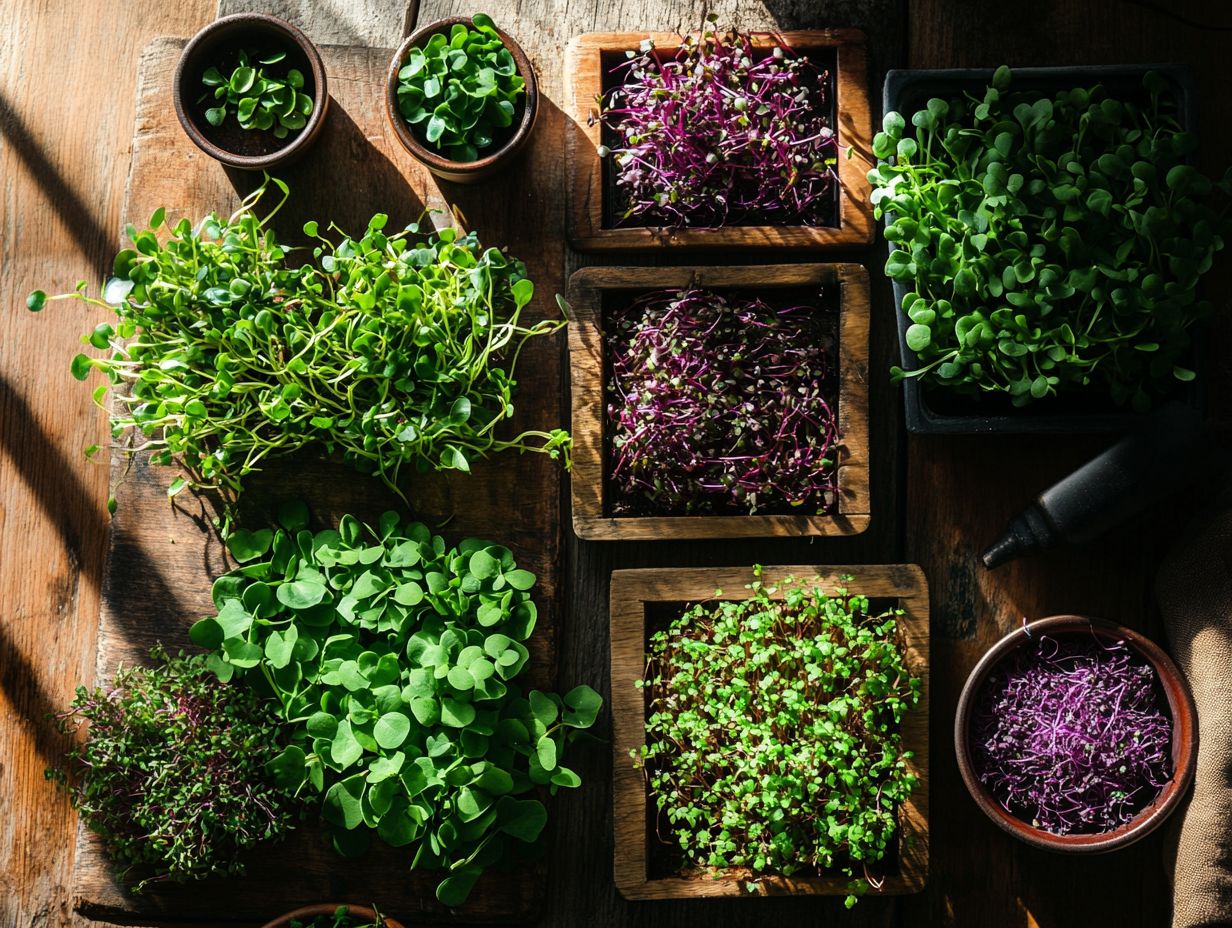
Incorporating microgreens into your diet can transform your meals, elevating them to a new level of culinary sophistication. These tiny powerhouses offer a plethora of recipe ideas that not only showcase their unique flavors but also enhance the nutritional quality of your functional foods.
Recipe Ideas and Tips
There are countless ways to incorporate microgreens into your meals, from vibrant salads to energizing smoothies. They highlight versatility and impressive nutritional benefits in the culinary realm, making them perfect for a health-conscious diet.
These vibrant little greens bring a burst of flavor and a generous dose of vitamins to any dish. Imagine using them as a refreshing salad foundation, paired with citrus fruits and a zesty vinaigrette that elevates the flavors. You can also blend microgreens into your smoothies, enhancing both the nutritional profile and taste with their unique essence. To learn more about their advantages, check out the health benefits of microgreens explained.
They can be sprinkled atop a warm grain bowl or folded into omelets, adding delightful texture and nutrients. To maximize their benefits, store microgreens in a cool, dry place. Rinse them gently before use to maintain their delicate structure and vibrant flavor, ensuring their short shelf life is managed effectively. For a deeper understanding of their benefits, check out microgreens vs. regular vegetables: a nutritional comparison.
Why Microgreens Outshine Other Superfoods
When comparing microgreens to other superfoods, their remarkable nutrient content truly stands out. They provide significant health benefits without breaking the bank, making them a compelling choice for those who prioritize their well-being.
Nutrient Content and Cost Comparison
Microgreens often deliver higher concentrations of vitamins and minerals than many conventional superfoods, and they usually come at a lower cost.
These miniature powerhouses pack a serious punch, often boasting levels of vitamins C, E, and K that outshine those found in mature greens like kale. In comparison to other beloved superfoods, such as chia seeds, known for their omega-3 fatty acids and fiber, the best microgreens for nutritional value offer a more diverse array of natural compounds found in plants that support health.
From a cost perspective, microgreens are a more budget-friendly choice, as they require significantly less space and time to cultivate. It’s easy to incorporate them into your daily meals; toss them into salads, blend them into smoothies, or use them as vibrant toppings on sandwiches and wraps to enhance flavor and nutrition. For health enthusiasts, exploring the top microgreen varieties can provide even more benefits.
Frequently Asked Questions about the Culinary World of Microgreens
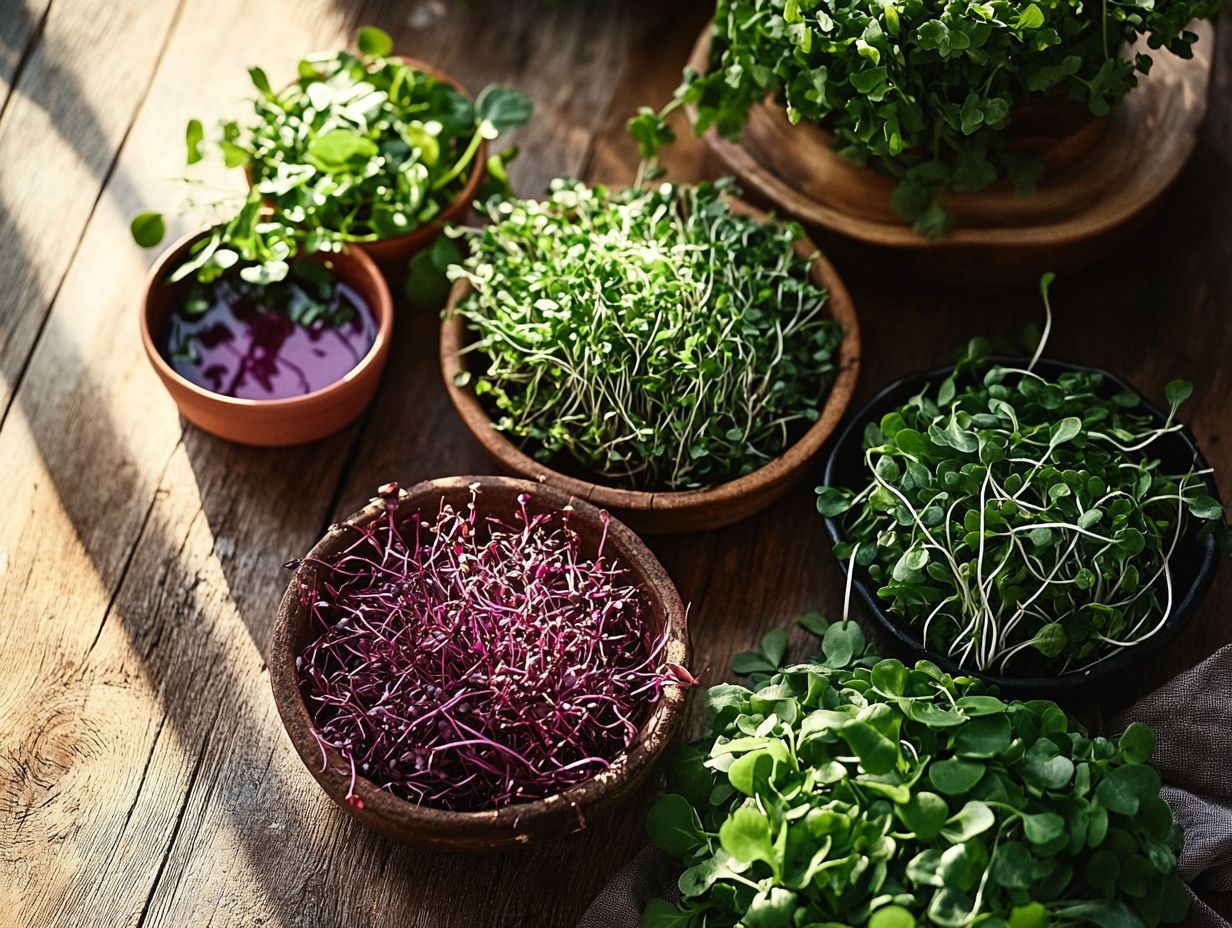
What are microgreens and what makes them a superfood?
Microgreens are young, edible plants harvested at a very early stage of growth, typically within 7-14 days after sprouting. Their high concentration of nutrients, antioxidants, and other beneficial compounds make them a superfood.
What types of microgreens are commonly grown and consumed?
Common types of microgreens include broccoli, kale, arugula, radish, and sunflower. Almost any herb or vegetable can be grown as a microgreen.
How do microgreens differ from sprouts?
Microgreens are often confused with sprouts. Microgreens are grown in soil and harvested after the first set of true leaves appear, while sprouts are grown in water and harvested before the first leaves develop. Microgreens have a higher concentration of nutrients than sprouts.
What are some benefits of incorporating microgreens into your diet?
Microgreens are packed with nutrients, including vitamins, minerals, and antioxidants. They can help boost the immune system, improve digestion, and promote healthy skin. They are low in calories and add flavor and texture to meals.
How can microgreens be incorporated into meals?
Microgreens can be used in salads, sandwiches, smoothies, and soups. They serve as garnishes or toppings for dishes, and can even be blended into pesto or hummus for added nutrition.
Don t miss out on the chance to boost your meals with these nutrient-packed greens!
Are there any precautions to take when eating microgreens?
Microgreens are a fun addition to your meals, but be cautious! Wash them thoroughly to remove any bacteria or dirt.
If you have allergies to certain plants, avoid microgreens from those plants.

